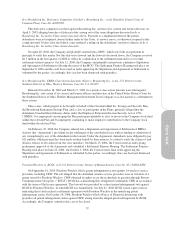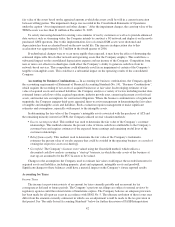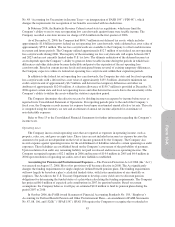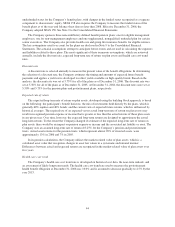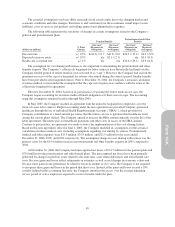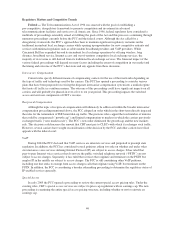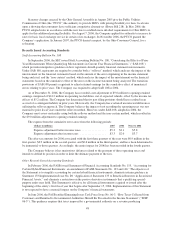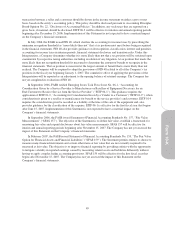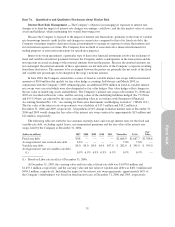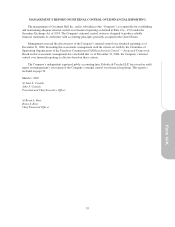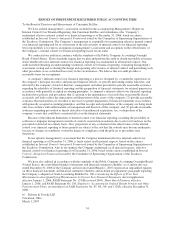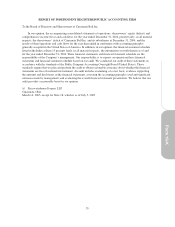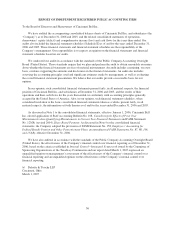Cincinnati Bell 2006 Annual Report Download - page 156
Download and view the complete annual report
Please find page 156 of the 2006 Cincinnati Bell annual report below. You can navigate through the pages in the report by either clicking on the pages listed below, or by using the keyword search tool below to find specific information within the annual report.Regulatory Matters and Competitive Trends
Federal — The Telecommunications Act of 1996 was enacted with the goal of establishing a
pro-competitive, deregulatory framework to promote competition and investment in advanced
telecommunications facilities and services to all Americans. Since 1996, federal regulators have considered a
multitude of proceedings ostensibly aimed at fulfilling the goals of the Act and this process is continuing through
numerous proceedings currently before the FCC and the federal courts. Although the Act called for a
deregulatory framework, the FCC’s approach has been to maintain significant regulatory restraints on the
traditional incumbent local exchange carriers while opening up opportunities for new competitive entrants and
services with minimal regulation such as cable modem broadband providers and VoIP providers. While
Cincinnati Bell has expanded beyond its incumbent local exchange operations by offering wireless, long
distance, broadband service, Internet access and out-of-territory competitive local exchange services, the
majority of its revenue is still derived from its traditional local exchange services. The financial impact of the
various federal proceedings will depend on many factors including the extent of competition in our market and
the timing and outcome of the FCC’s decisions and any appeals from those decisions.
Intercarrier Compensation
Current rules specify different means of compensating carriers for the use of their networks depending on
the type of traffic and technology used by the carriers. The FCC has opened a proceeding to consider various
plans that have been proposed for revising the disparate intercarrier compensation system into a unified regime
that treats all traffic in a uniform manner. The outcome of this proceeding could have significant impacts on all
carriers and will probably be phased-in over a five to ten year period. This proceeding impacts the switched
access and end-user components of CBT’s revenue.
Reciprocal Compensation
Although the topic of reciprocal compensation will ultimately be addressed within the broader intercarrier
compensation proceeding mentioned above, the FCC adopted an order which in the short-term directly impacted
the rules for the termination of ISP-bound dial-up traffic. The previous rules capped the total number of minutes
that could be compensated (“growth cap”) and limited compensation to markets in which the carriers previously
exchanged traffic (“new markets rule”). The FCC’s new order eliminated the growth cap and the new markets
rule. This decision could increase the amount that CBT must pay to CLECs with which it exchanges such traffic.
However, several carriers have sought reconsideration of the decision by the FCC and other carriers have filed
appeals with the federal court.
VoIP
During 2004 the FCC declared that VoIP services are interstate services and purported to preempt state
regulation. In addition, the FCC has considered several petitions asking it to rule on whether and under what
circumstances voice services utilizing Internet Protocol (IP) are subject to access charges. It has ruled that
peer-to-peer Internet voice services that do not use the public switched telephone network (“PSTN”) are not
subject to access charges. Separately, it has ruled that services that originate and terminate on the PSTN but
employ IP in the middle are subject to access charges. The FCC is still considering other VoIP petitions,
including one that seeks to exempt from access charges calls that originate using VoIP, but terminate on the
PSTN. In addition, the FCC is considering a broader rulemaking proceeding to determine the regulatory status of
IP-enabled services generally.
Special Access
In early 2005 the FCC opened a proceeding to review the current special access pricing rules. Under the
existing rules, CBT’s special access services are subject to price cap regulation with no earnings cap. The new
proceeding is examining the entire special access pricing structure, including whether or not to reinstate an
earnings cap.
46



